Preamble
While I was on a holiday in my home country Nepal during October - November 2021, I and some of my friends were planning a hiking trip to the mountainous regions of Nepal. After some considerations on where to go, we decided to hike to Tsho-Rolpa lake and back.
Tsho-Rolpa lake trail is not one of the popular trekking routes so we would have less crowd along the way which was definitely a plus in COVID times. Since the destination is a glacial lake severely threatened by the risks of global warming and climate change, we had decided to visit there also to remind ourselves what we and the future generations would be missing if we don't take actions towards mitigating the effects of human activities.
Introduction
Tsho-Rolpa (NE: च्छोरोल्पा) lake, located at 4,580m from sea level in Nepal is one of the biggest glacial lakes of the country. The outflows of the lake form the Rolwaling (रोल्वालिङ) and the Tamakoshi (तामाकोशी) river. The lake is situated in the Rolwaling valley in Dolakha district and is part of the Gaurishankar(गौरीशंकर) Conservation Area. The conservation area gets its name from Mount Gaurishankar (7,134m) which is located there and our trek involves walking along the base of the mountain for quite some time.
Fun fact: The Nepal Standard Time (UTC +5:45) is based on the meridian of Mount Gaurishankar.
Itinerary
The Tsho-Rolpa trek is usually a 7-9 days trip but we were constrained by time and had to squeeze it into 5 days. We knew we had to walk extreme lengths of the trail each day because of this and we were mentally prepared for it.
The regular trek duration of 7-9 days also considers acclimatization and is recommended for people who are not used to high altitudes so they don't suffer from altitude sickness. We had been to high altitudes in the past with no such problems, so we could skip a day for acclimatization. But we were still prepared to go back to a lower altitude if any of us started having debilitating effects from the high altitude.
Trip summary
- Total elevation change: 3,500m
- Motorbike ride time: 15 hours
- Hiked time: 42.5 hours (breaks included)
- Difficulty Level: Moderate/Difficult

Day 1: Bhaktapur (भक्तपुर) - Chhetchhet (छेतछेत) - Surmuche (सुर्मुचे)
- Altitude: Bhaktapur (1,400m) - Chhetchhet (1,398m) - Surmuche (2,470m)
- Motorbike ride time: 7.5 hours
- Hiked time: 4.5 hours
Bhaktapur - Chhetchhet motorbike ride
We(me and three friends) started the trip very early, at 5 am from our hometown Bhaktapur in the Kathmandu valley. We were going to ride our motorbikes until the last point where we could and then start the actual trek from there.
Despite our effort to procure 3 motorbikes for the trip, we could manage only two, so there were 2 persons on each motorbike along with our backpacks. I rode my younger brother's KTM Duke 200cc motorbike whose engine was quite powerful which made riding on off-road trails a lot easier. However, the smaller seat size didn't make for a comfortable ride for two persons with heavy backpacks.
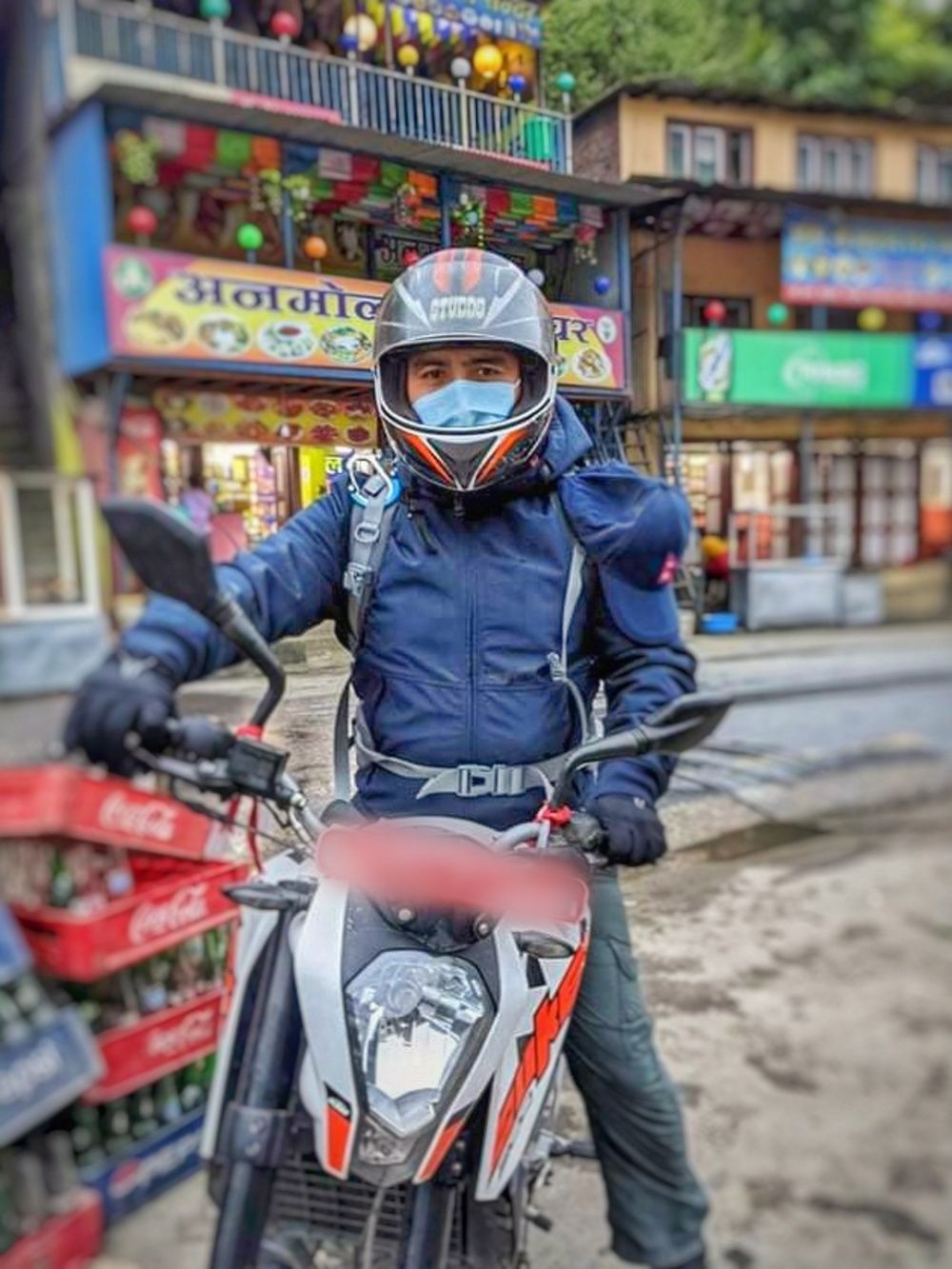
We stopped at Charikot, the headquarter of Dolakha district for a lunch break before continuing our journey via Singati. We also made several other breaks along the way, of course, to take a rest and also enjoy the beautiful views of the Himalayan mountain range and a plethora of waterfalls along the way.
The Gaurishankar Conservation Area starts from Singati and an entrance fee needs to be paid. Extra documents and trekking permits might be required for foreigners.
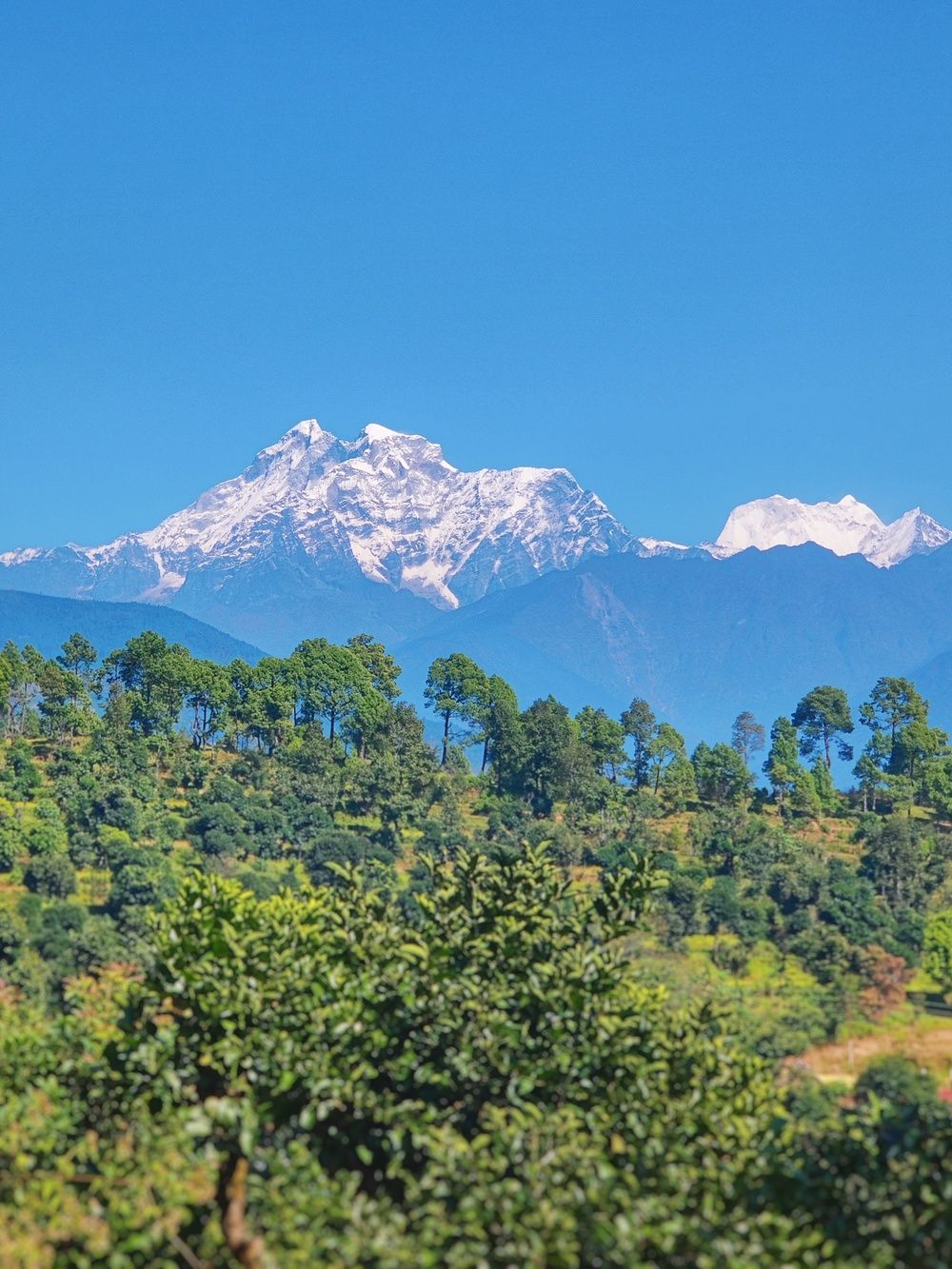
We rode the motorbikes for around 7.5 hours through the windy roads of the hilly regions of Nepal before reaching Chhetchhet from where we would start the hiking part of our journey.
Shortly before reaching Chhetchhet, we came across a gorgeous waterfall flowing to the turquoise-blue water of the Tamakoshi river. In addition, a rainbow had formed in front of it that made the view even more surreal.
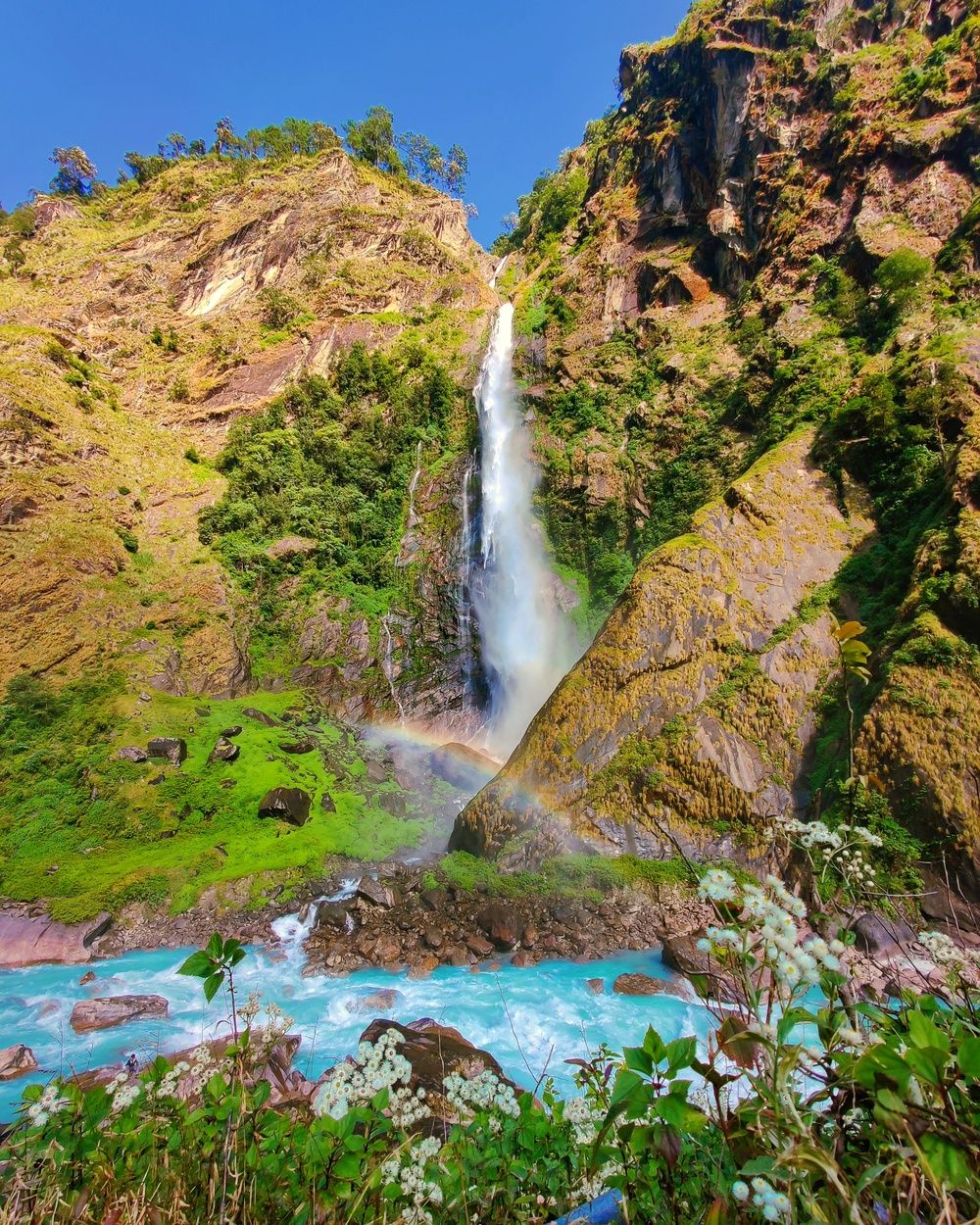
Although we used motorbikes, the most common way to arrive in Chhetchhet from Kathmandu is via public transport. You can take a bus from Kathmandu to Singati and then a jeep to reach Chhetchhet. Alternatively, you can also reserve a jeep directly from Kathmandu to Chhetchhet.
Chhetchhet to Surmuche trekking
After leaving our motorbikes on a secure garage in Chhetchhet and resting for a while we started the actual hike at 3 pm. Upon seeing the first path that we had to climb, a huge hill with an almost vertical climb to the top, we were a bit overwhelmed, to say the least. However, we were excited for our overall journey so we braved the trail. The first half-hour was extremely hard as our body had not warmed up enough so to say but as we got the hang of it, the walk started becoming easier.
Three hours of walk and a few breaks later, we reached the village of Simigaun. This is the final village up to where the electricity grid is connected, so it is usually the first-day destination for people doing the Tsho-Rolpa trek where they charge their electronics overnight. However, this was not our planned destination for the day and we were going to continue further to the next village.
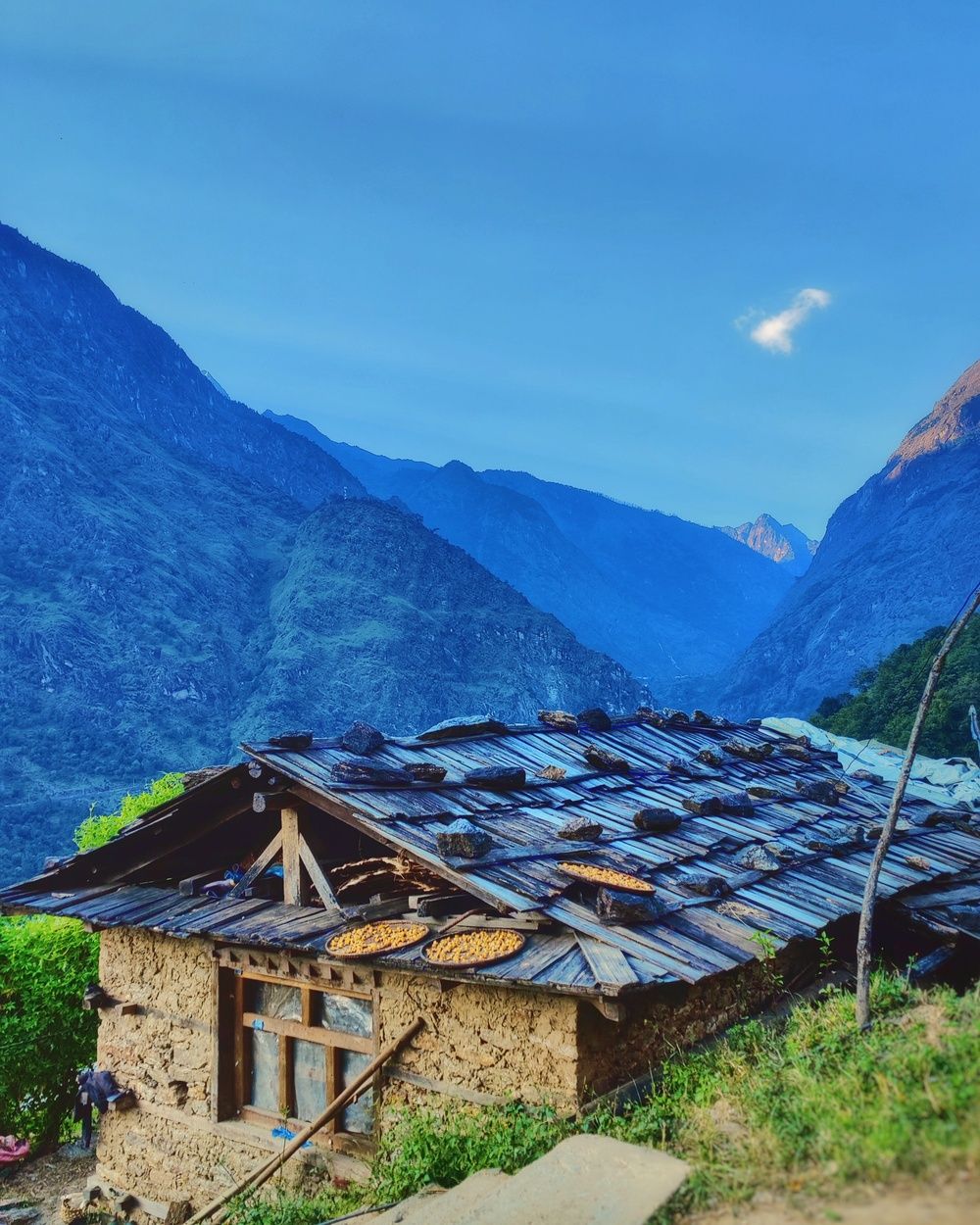
After walking for another 2.5 hours, most of it in the dark, with only headlamps and flashlights lighting our way we reached our destination Surmuche. All of us were fatigued and wanted to have a hearty meal to replenish our lost energy at the hotel/teahouse there. There was only one teahouse at this destination and the next village was at least 3 hours away.
We were fortunate that the teahouse in Surmuche was open but unfortunately we couldn't have a hearty meal because the owner himself had made the same journey we made from Surmuche, arriving just an hour ago. So he was tired too and also a bit under the weather. Despite this, he showed us our accommodation for the night and made tasty noodle soup for us. It was more than enough for us and we had carried some snacks with us anyway, so we could have them if we didn't feel satiated. With another day of a long walk ahead of us and the exhaustion from the day's bike ride and walk, we didn't waste much time going to bed.
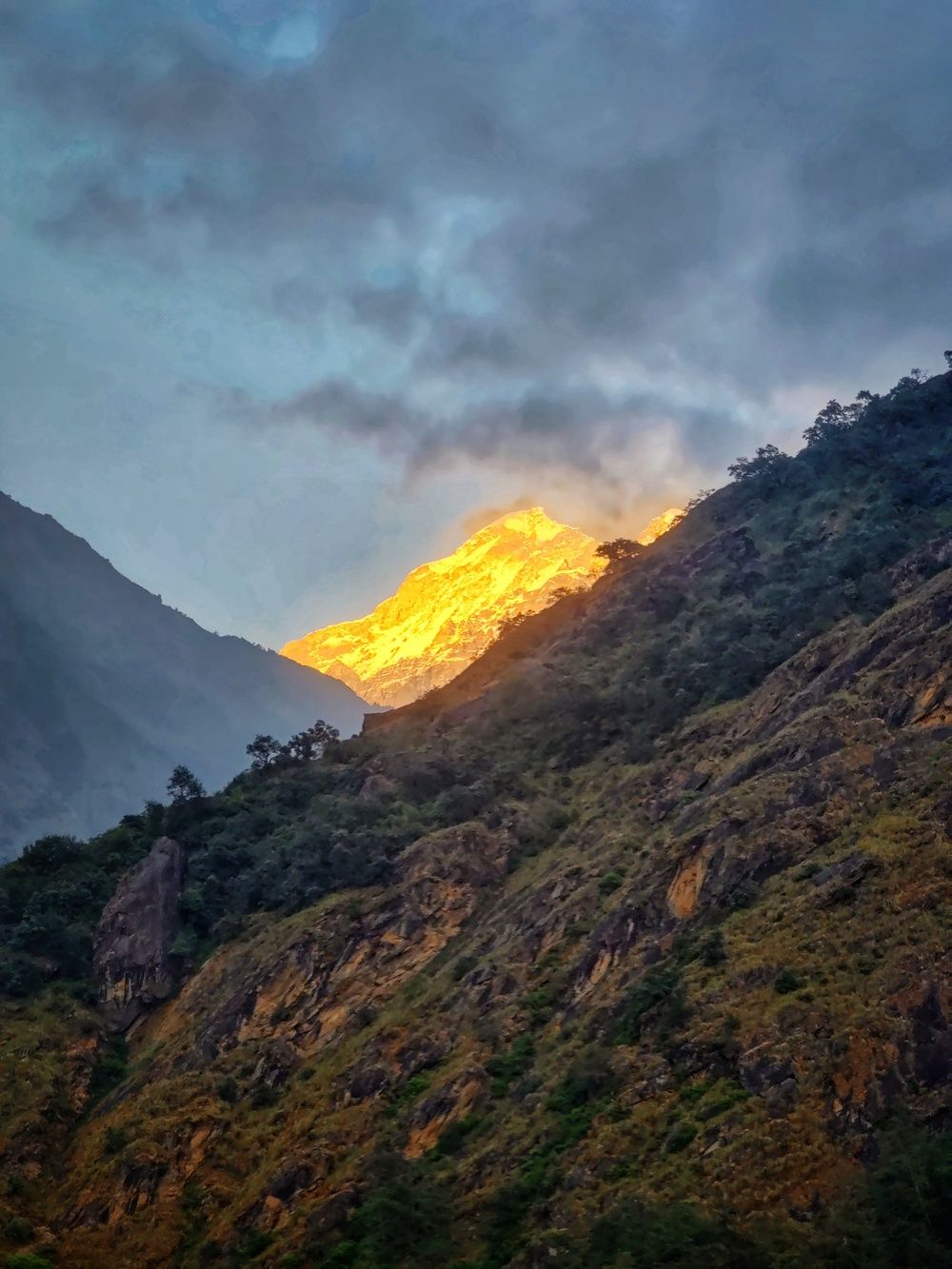
Day 2: Surmuche (सुर्मुचे) - Beding (बेदिङ्ग)
- Altitude: Surmuche(2,470m) - Beding (3,721m)
- Hiked time: 12 hours
We had an ambitious plan for our second-day hike, so we woke up early at 6 am, had our breakfast, and immediately started our hike. This was also an uphill hike but the elevation change didn't feel as aggressive as the previous day, or maybe we got used to it.
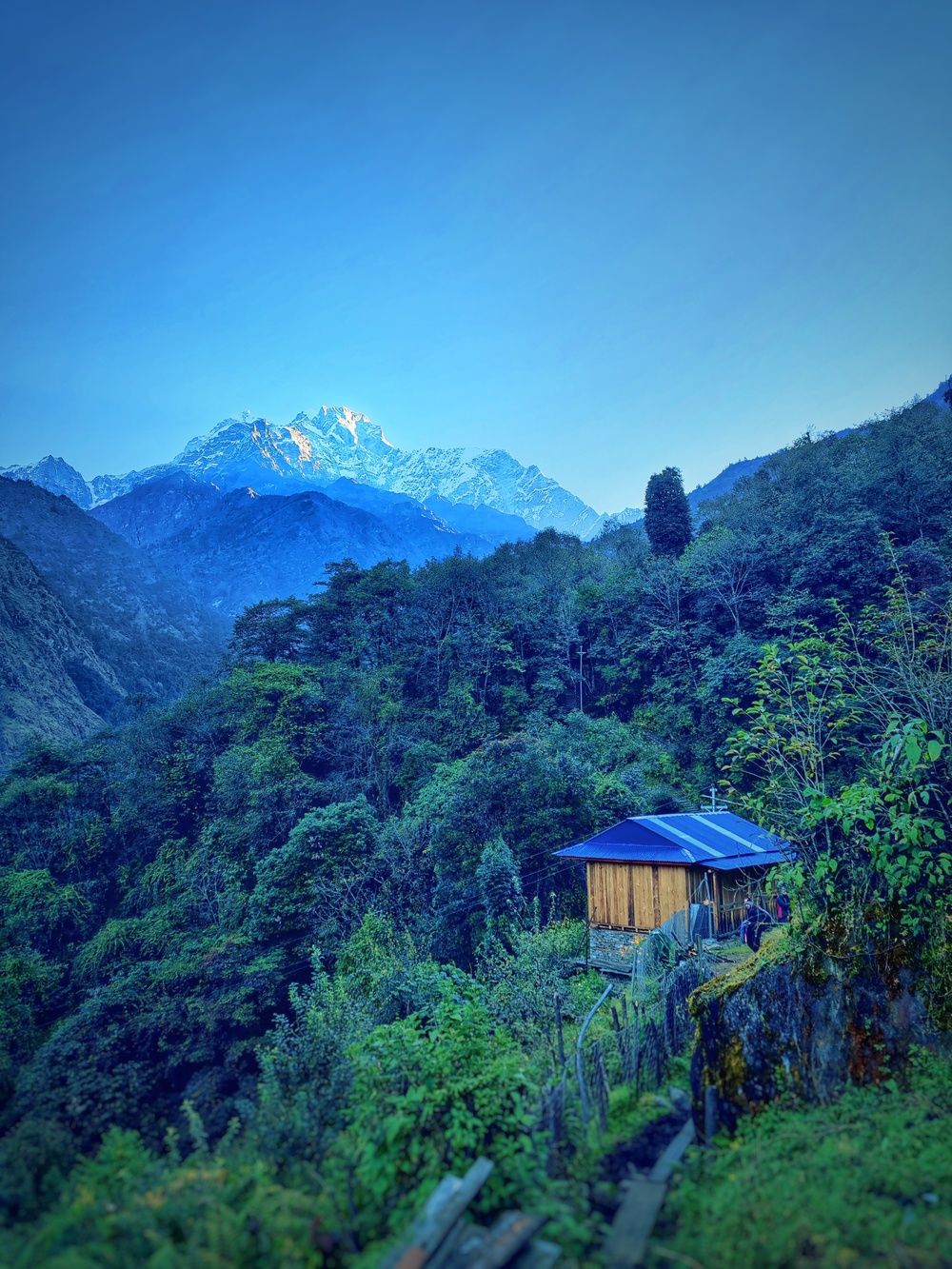
After hiking for about 2 hours we reached the next stop of Kyalche. Since we were not much tired and hungry either, we decided to continue our hike after stopping here for a short rest and taking some pictures.

We noticed that we stopped getting the cellphone network reception at some point. Although concerning at first, it allowed us to be more present in the moment and soak in the views during our rest time rather than going to social media to post our pictures or see what other people are up to.
Hiking for another 2 hours with little to no elevation change, we reached Dongang (डोंगांग). Dongang is a small settlement along the Tamakoshi river with turquoise blue water. Perhaps it is beacuse the source of this river is the mountains and glaciers not so far away that the water got its almost surreal color from the minerals present.
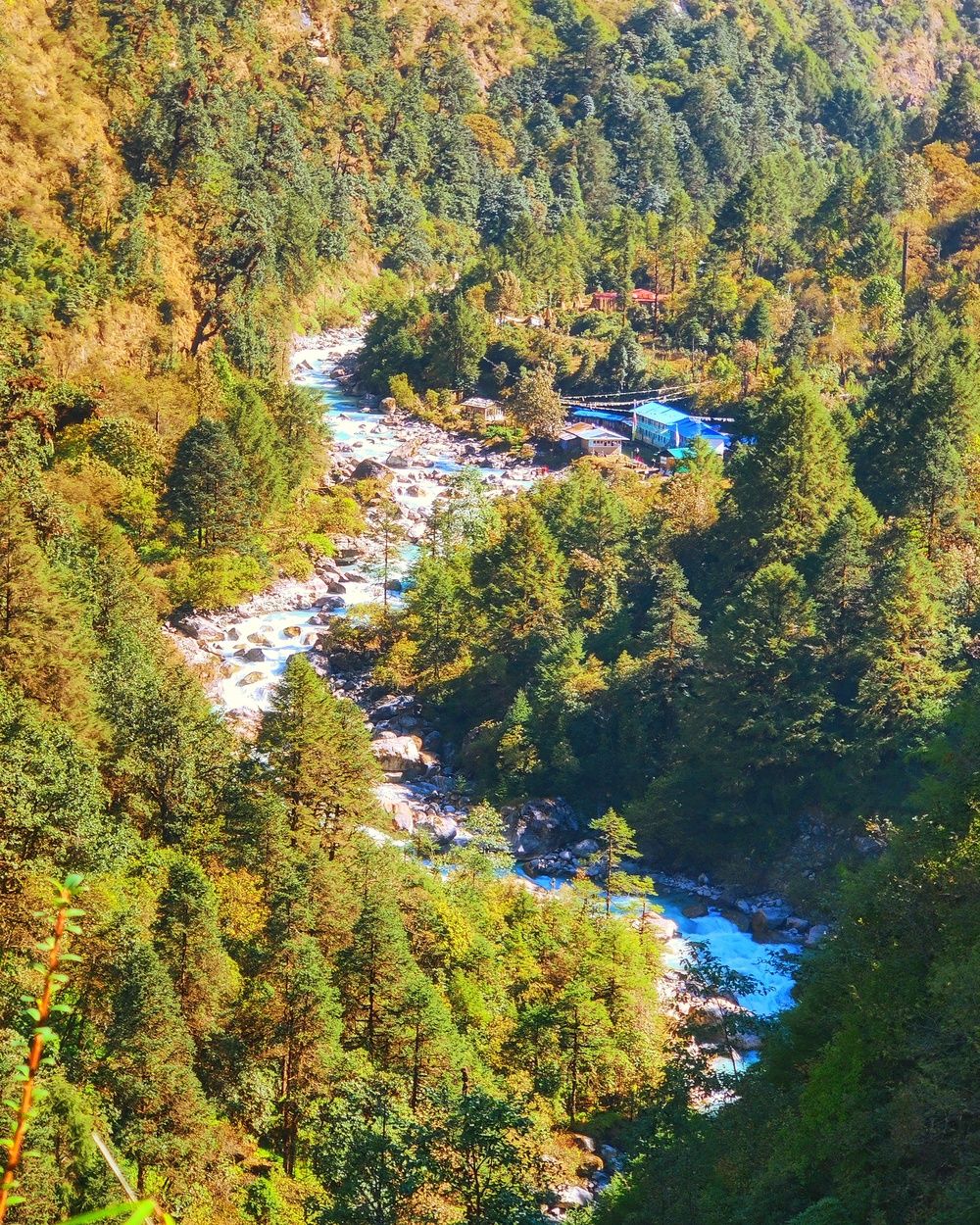
Since we were famished while reaching here and the next stop was hours away, we stopped and ordered Dal-Bhat(rice with lentils and vegetables on the side), the quintessential Nepali food. Our clothes were drenched with sweat from the long hike and sunny day, so we also took the time to dry them up and rested until the food was ready. After having a hearty meal, we rested a bit more as we were in no position to start walking immediately.
We resumed the hike from Dongang at around 1 pm. The mountains started to feel like they were getting nearer which made us excited to continue the journey. We had to walk along the Tamakoshi river for a good amount of time and we surely didn't complain as the view of the turquoise-blue river water was something that we couldn't get enough of. After a while, we began to notice that the vegetation was changing and starting to be more alpine-like.
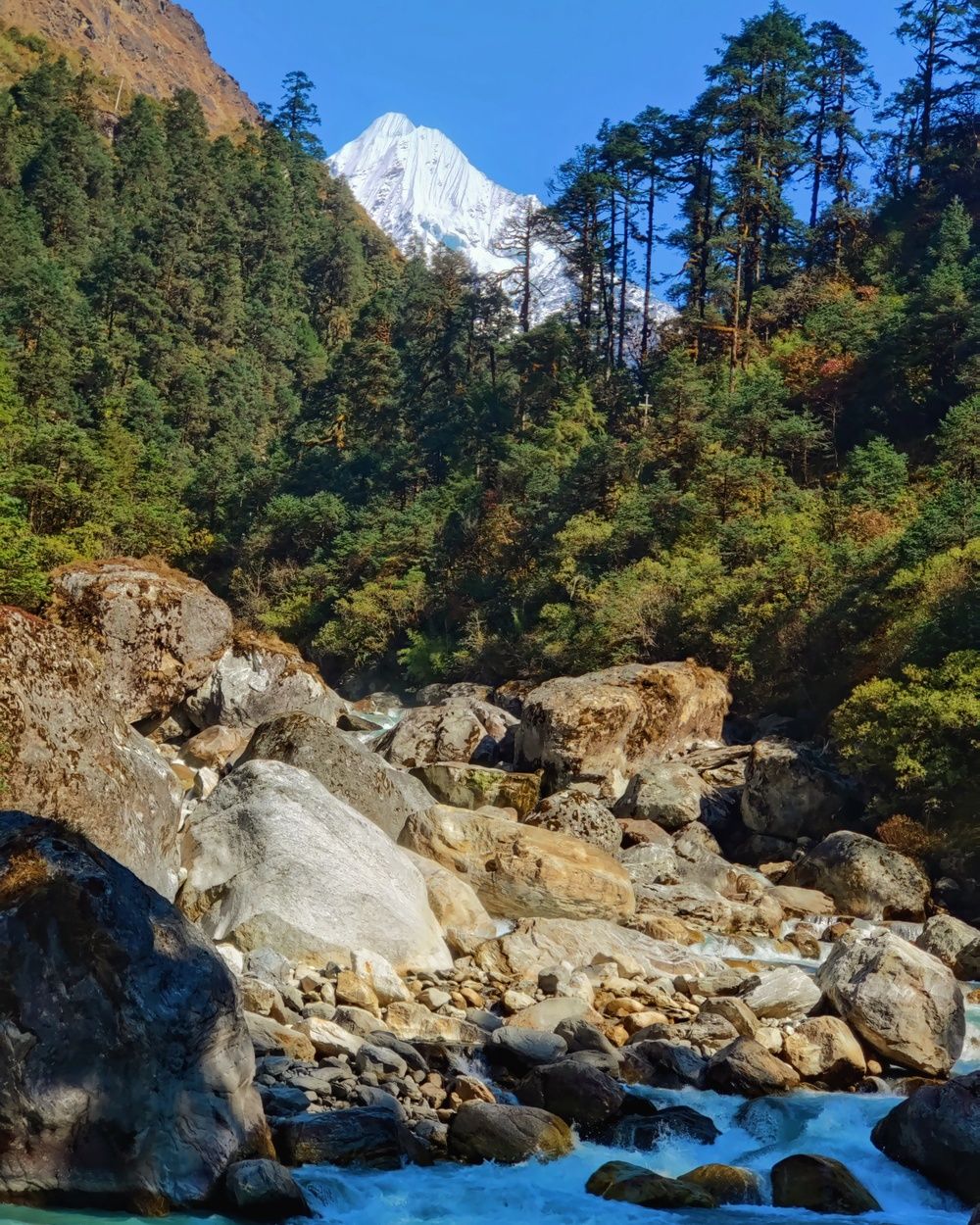
At around 6 pm, when it was starting to get dark we reached the village of Beding. Since we were too tired and some of us were starting to feel the effects of the high altitude, we were ecstatic to see the signpost of the village where we could stay for the night. To our dismay, it turned out that the lodges were at the other side of the village which took us 45 more minutes to reach and that too in utter darkness with only our headlamps and flashlights to light up the path.
In the lodge in Beding, we had some Tibetan noodles soup alongside the fire in the kitchen to quickly warm us up before having our dinner off Daal-Bhat. The weather was so cold in Beding and the lack of internal heating in our rooms meant that we had to have multiple layers of blankets on top of us to keep us warm during the night.
Day 3: Beding (बेदिङ्ग) - Tsho-Rolpa (च्छोरोल्पा) - Na (ना) village
- Altitude: Beding (3,721m) - Tsho-Rolpa (4,550m) - Na village (4,180m)
- Hiked time: 12 hours
Beding, also known as the village of Everest climbers was where we stayed during the second day of our trip. Since we had arrived in darkness, it was a pleasant surprise when we got to see the beautiful views of the mountain directly from our lodge in the morning.
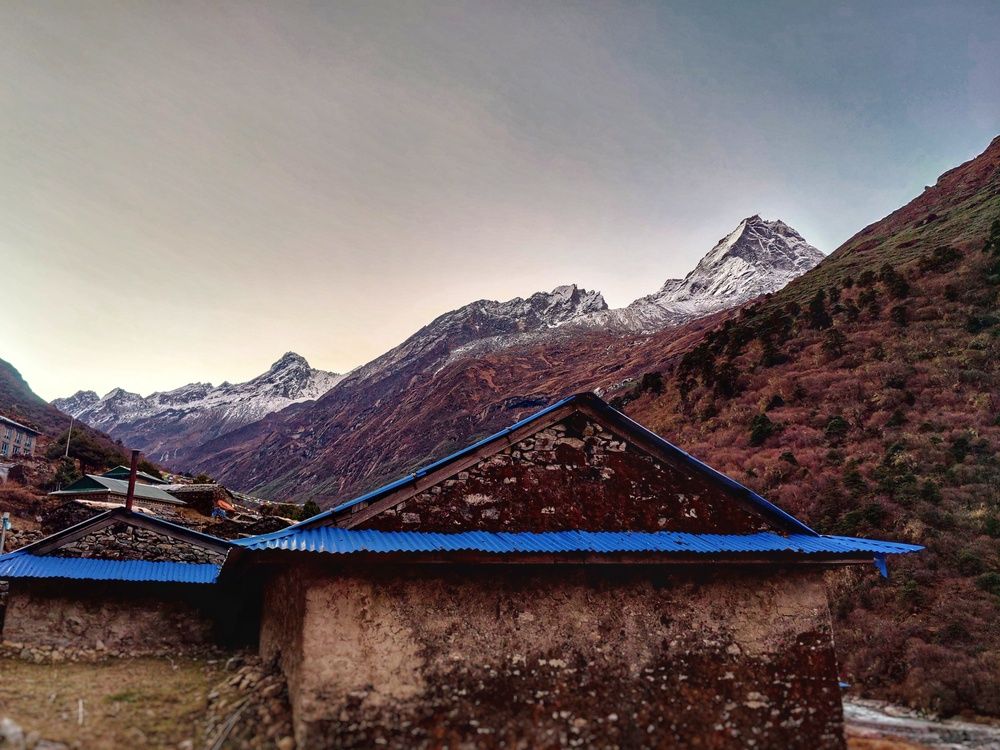
On the third day, we didn't waste any time having breakfast and immediately started the hike at 7 am, soon after waking up. This was the first day where we didn't have to gain significant elevation during our hike. The path was mostly straight with only minor elevation changes.
Along the way, we could experience the magnificent views of the Rolwaling valley. In the local Sherpa language, Rolwaling means "valley carved by a plow" and looking at the landscape certainly gave that resemblance.
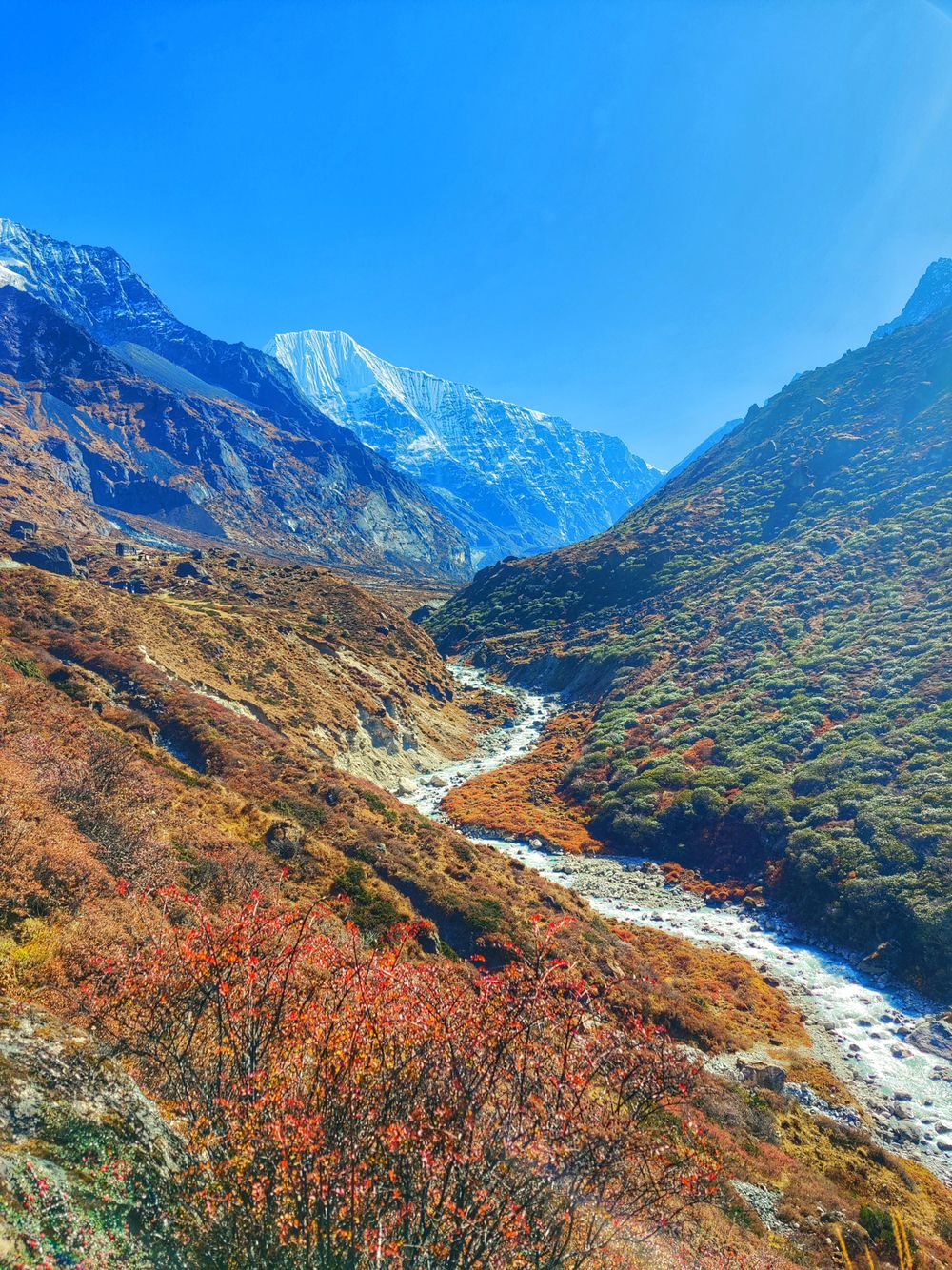
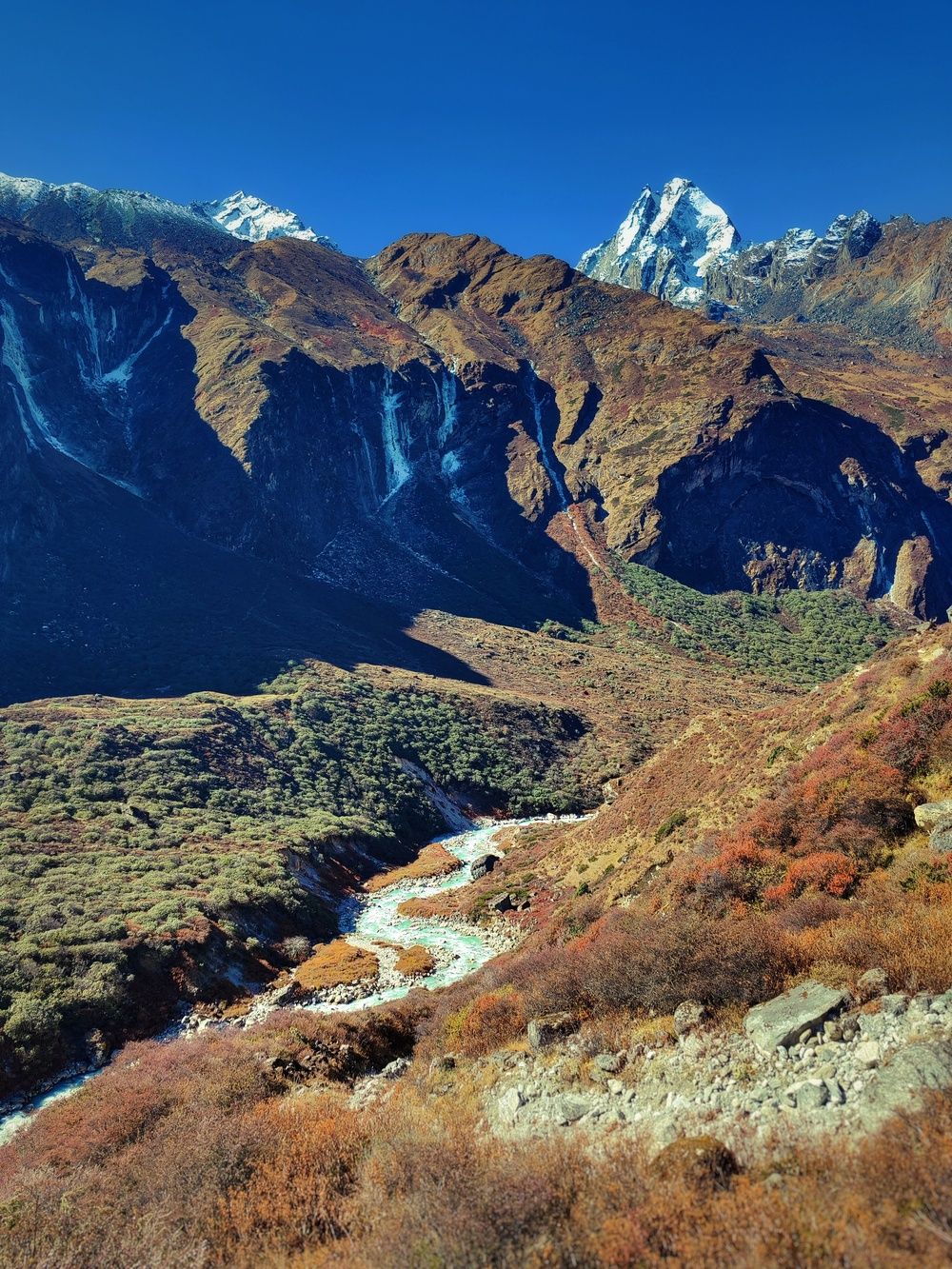
We reached the village of Na at 11 am, rested for a while at a lodge there, and had our breakfast/lunch. We left our bags here, taking only the essentials we needed for the day as we were going to come back and stay here for the night after reaching our destination of Tsho-Rolpa lake. It was almost a magical feeling for me to not have to carry the 12 kilos of weight that I had been carrying the past days.
Walking alongside the Tamakoshi river on almost flat terrain, for the most part, we reached Tsho-Rolpa lake at 3:30 pm. The weather was in our favor that day and we were able to have clear views of the Tsho-Rolpa lake and the mountains when we reached there. We had heard that on most days it's almost impossible to have a clear view of the lake after 11 am due to the fog that envelopes the lake and the surrounding mountains.
It was a surreal feeling to finally have reached our destination after the grueling walk and the pain we endured the past few days. We took some time to bask in the magnificent view of the lake, the mountains, and also the Rolwaling valley behind us. We also met other travelers there, all of them from Nepal who had come to visit the lake.
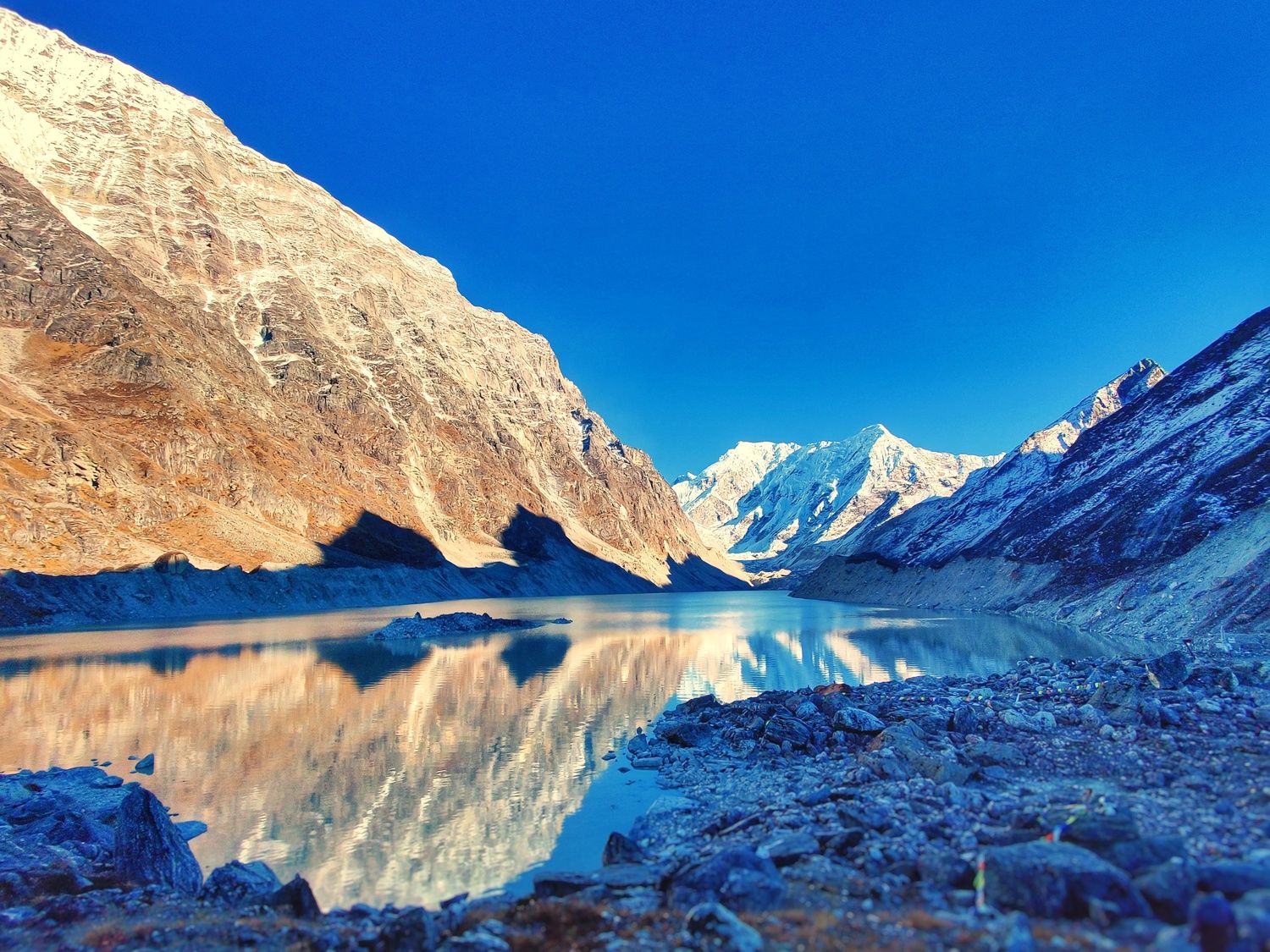
Despite the captivating view, we couldn't stay there for long as we were losing light and had to return soon. In addition, it was so windy and chilly there that it wasn't possible to spend more time there. There are no hotels, lodges, or teahouses near the Tsho-Rolpa lake so everyone had to return unless they were planning on camping there.
While making our descent from the lake towards the Na village in the Rolwaling valley, we could see golden hour starting to set in causing beautiful light in the horizon on front of us.
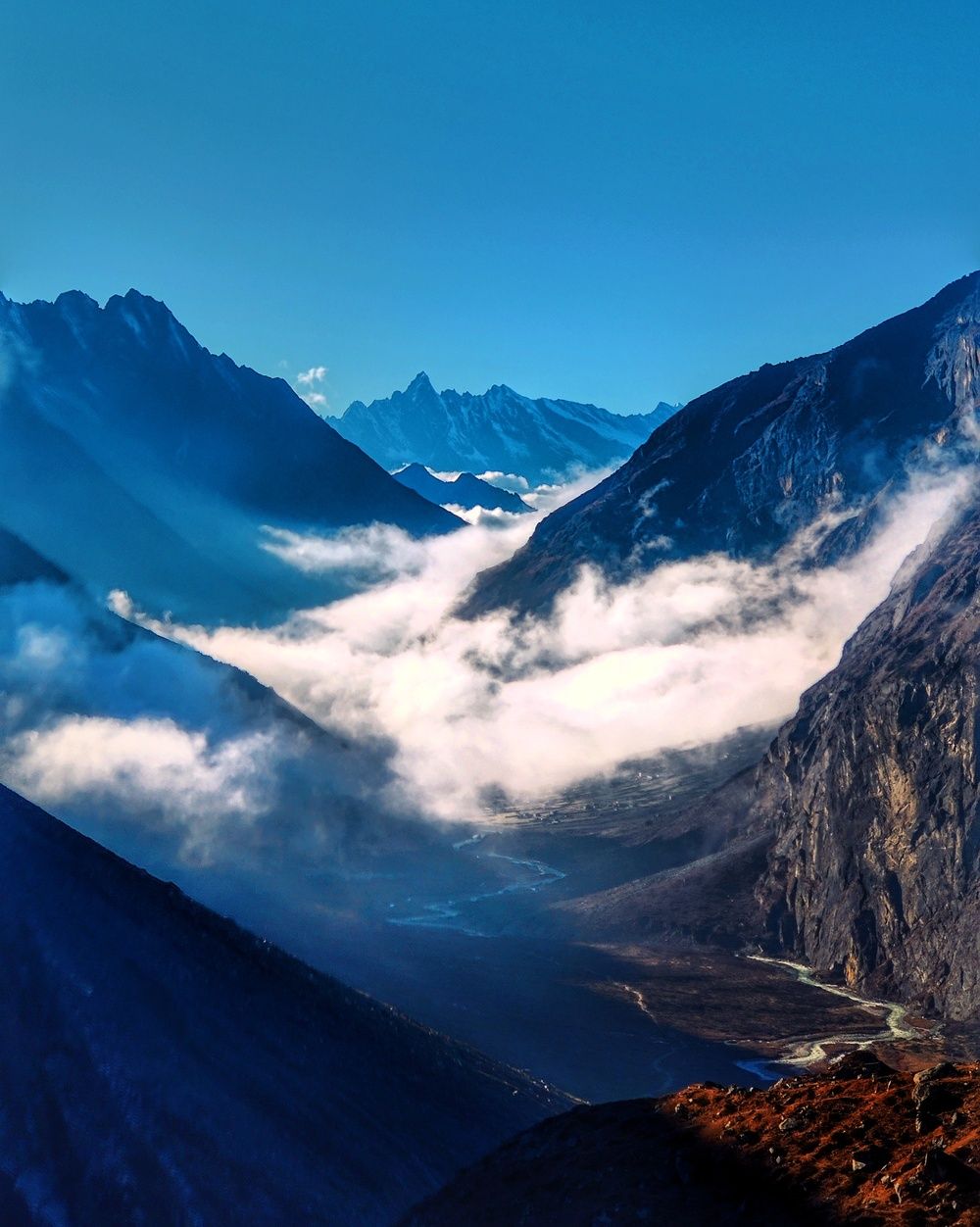
When we looked back, we could also see the last light of the day shining on top of the mountains, which was an exquisite view of its own.
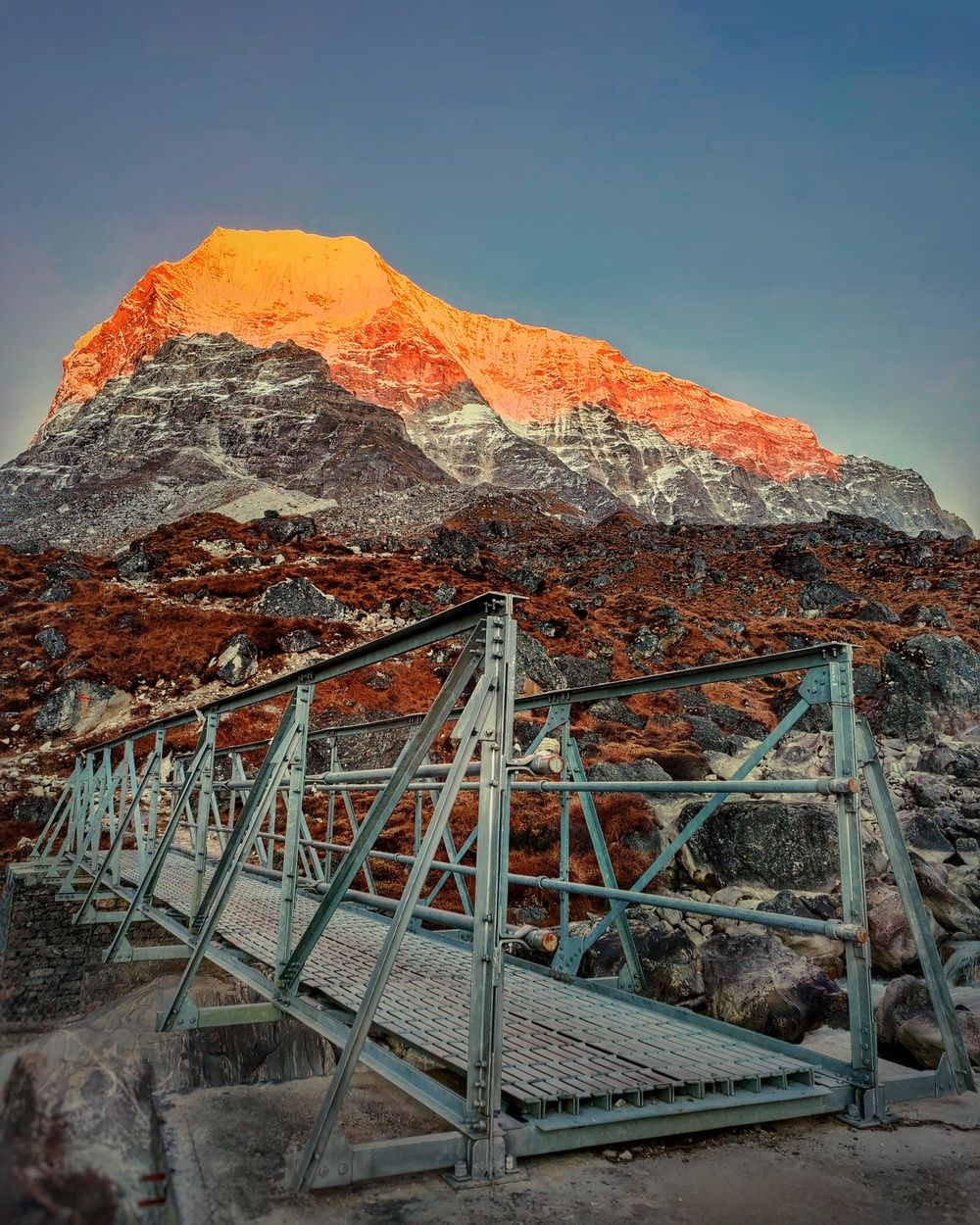
Like the previous days, we reached our destination in utter darkness and sat by the fire to warm ourselves up with some soup before having our dinner. We also took time to reflect on our journey and how we were able to achieve the ambitious feat of reaching the Tsho-Rolpa lake in 3 days. Except for seasoned trekkers, it is at least a 4 days trip just to reach the lake and we were proud of ourselves for having done that in 3 days despite not having much experience trekking to such a high altitude.
Although we were too tired, it wasn't easy to fall asleep because of the high altitude and the cold. We did manage to get to sleep after a while of trying.
Day 4: Na (ना) village - Simigaun (सिमिगाउँ)
- Altitude: Na village (4,180m) - Simigaun (2,000m)
- Hiked time: 12 hours
Since it was mostly a downhill hike back, we had planned to walk a long distance today to have an easy time the next day. We started our hike at 7:30 from the Na village after having breakfast. We didn't make many stops along the way apart from a few snack breaks as going downhill was easier and we had to walk a long distance to cover during the day.
We reached Dongang at 2 pm where we had our lunch and resumed our journey soon after. Similar to the previous days, we only managed to reach our destination in the dark. It was already 7 pm when we reached Simigaun. Most of our electronics were low on battery so we recharged them here where there was grid-connected electricity. The power banks that we had brought and the spare batteries from the GoPro and the drone had lasted us till then.
As we didn't have a chance to properly celebrate our reaching our destination the previous night, we treated ourselves to Tongba, an alcoholic drink made from fermented millet. We mulled over our journey, life, and philosophy in general, as is usually the case when alcohol is involved.
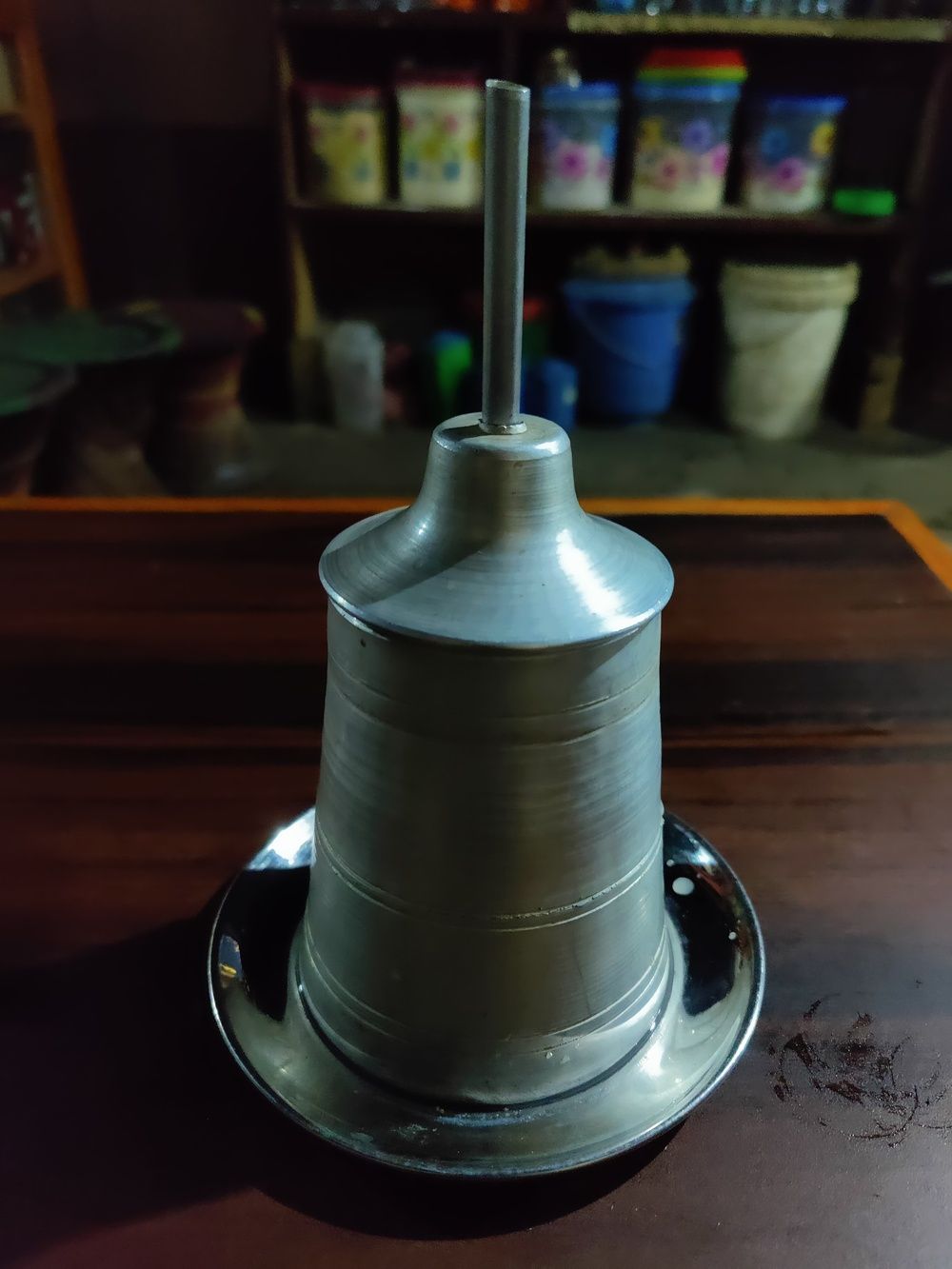
After a while, we had our dinner and went to sleep planning to wake up early the next day as we still had a few hours of hike left before we could reach Chhetchhet where our motorbikes were waiting for us to continue our journey back home.
Day 5: Simigaun - Bhaktapur
- Altitude: Simigaun (2,000m) - Bhaktapur (1,400m)
- Hiked time: 2 hours
- Motorbike ride time: 7.5 hours
We started our journey at 7 am without having breakfast. We reached Chhetchhet at 9 am. The last 30 minutes of our walk felt extremely arduous to me because I was having knee problems walking downhill on the stone-paved stairs. It must've been due to the extreme distance we covered the previous day walking downhill too. However, I was glad that this happened to me towards the end of the trek and not earlier. Otherwise, it'd been a nightmare and not a nice experience.
It was an immense relief for my knee and lower body in general after getting on my motorbike. Now it was the turn for my arms and hands to feel the pain of riding a motorbike on off-road and mostly uneven terrain. Braving the pain, we reached Dolakha Bazar where we made a short stop to visit the Dolakha Bhimeswor temple.
Our next stop was at nearby Charikot where we had the first meal of the day at noon. We also loaded our heavy bags onto a bus destined for Kathmandu to avoid having to carry the load on our back all the way home on our motorbikes.
Shortly after having lunch, we resumed our journey towards Bhaktapur and reached there at 6 pm. We were there just in time to retrieve our bags from the bus. Although the journey via motorbike is usually a lot faster than taking the local bus, we arrived at around the same time as we made a few stops along the way to rest and also for having something to eat in Dolalghat.
My whole body was in pain when I reached home after our grueling journey. I couldn't wait to rest and not do anything for the next few days.
Closing Thoughts
The overall journey was one of the best experiences of my life. The majestic views along the way and the well-maintained trails in the Gaurishankar Conservation Area made for a pleasant hike despite the long hours we had to walk. Having good friends accompanying me on the trip made it even better.
Despite the beautiful journey we had, we couldn't help but wonder about the fate of the people living below the lake and its outflows if the lake suddenly bursts. Due to global warming and rising temperatures, the risk is getting more severe every day. Although some efforts have been made to minimize the risk and to implement an early warning system in the area, it's not sufficient. The risk is still present unless something is done on a global scale to curb the rising temperatures and climate change.
Things we could've done differently
Since we squeezed a 7-9 days trip into five days, we had to walk up to 12 hours a day which felt arduous at times. The trip could've been a lot less stressful. But I think we did the best we could with our time constraints.
If we had more time we could also have hiked to the Dudh Kunda, a beautiful lake a few hours away from Tsho-Rolpa lake.
Although we didn't need it, it would've been smart to bring medicines to mitigate the effects of high altitude, just in case.
Lessons learned for life
Towards the end of our daily 12 hours trek, I was so exhausted that it felt like I couldn't continue further. Stopping in the woods in the dark was not an option, so I had to force myself to proceed despite the weariness and pain. This made me realize that we are capable of achieving a lot and most of the time our mind is the one limiting us.
Planning the journey and pre-determining the destination for each days made us accountable and determined. While on the hike, instead of getting overwhelmed by the long path ahead of us, it helped to think of only the next step in our journey. Having a bigger picture in mind and taking small steps to achieve it makes even the seemingly impossible possible.
The insights that I learned can be applied to overcome difficult challenges in other facets of life as well.
Why do you go away? So that you can come back. So that you can see the place you came from with new eyes and extra colors. And the people there see you differently, too. Coming back to where you started is not the same as never leaving.
I certainly felt that I became a different person, for the better after my journey.
Looking forward to more journeys to discover the beautiful world that we live in and also to discover my true self.
Addendum
- There were variations in the reported altitude of the places based on the sources
- Follow me on Instagram (@sub0dh_d) to view more pictures from this and other trips
